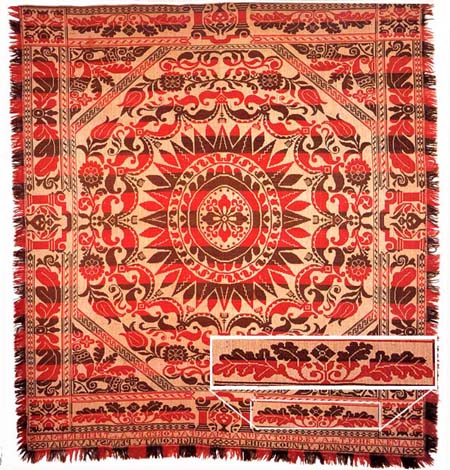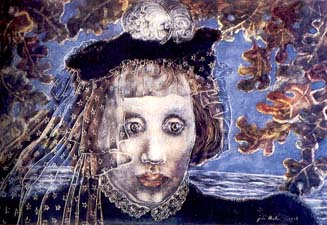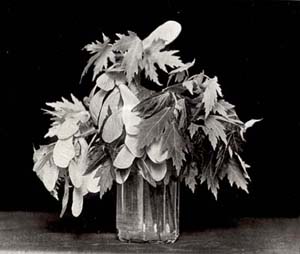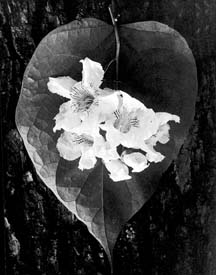Objective: Students
will become more aware of how artists use leaves as design motifs and as subjects
of art. Students will improve their visual thinking skills by: 1) identifying
the leaves with online leaf identification tools or guide books and 2) discussing
the theme and interpretation of the artworks with regard to the artist’s inclusion
of leaf motifs, Pretest students by asking them to identify the leaves in
the artworks and explain why they might be there. Students will improve their
online search skills using keywords in browsers to find symbolism and traditions
in design motifs and tree distribution.
Grades:
Upper Elementary - Middle School
Time Required: one 60-minute period. (15 minutes for tree i.d.; 15
minutes for online research on the leaf and its meaning as a design motif;
15 minutes to write up findings; 15 minutes to present all findings.)
Works
of Art included:
Frank Sadorus, Catalpa Blossom in Bloom, black and white photograph,
circa 1910.
Frank Sadorus, Still Life with Maple Leaves, black and white photograph,
circa 1910.
Julia Thecla, Self-Portrait (oak leaves), opaque watercolor, 1936.
Abraham and Thomas Fehr, Coverlet (oak leaves), cotton and wool, circa
1848-60.
Helen Gilchrist, Applique Coverlet (Tulip Poplar), cotton, 1848.
Motivation:
Some artists and artisans choose to portray elements of nature, such as leaves,
in their works of art. Some leaf designs are traditional, handed down through
generations, while others are original with the artist. By learning to notice
and identify natural elements in works of art, viewers can think about the
significance of the element to the artist, to the culture, to a religion,
and to himself. May the artist have thought that the leaf was so beautiful
that he or she just had to capture it? Is the leaf a symbol of something in
the culture, such as patriotism, royalty, beauty, longevity, etc.? Did the
artist create a design based on, but not identical to, a real leaf? Was a
particular leaf a popular motif of the time or season?
Materials:
Printout of artwork question sheets Leaf identification book or online tool
Hillview School’s Tree
ID site in Canada.
Iowa State's tree ID
site
Virginia Tech's
leaf and twig I.D.
Procedure:
- Review leaf identification procedures and terminology.
- Students or groups of students can choose or be assigned an artwork to
analyze and interpret from those presented in this lesson. Groups can assign
to their members tasks of leaf identification, researching meaning of the
artist, or meaning of motif in cultures.
- They proceed with research, discuss findings, come to a consensus, write it
up, and present it to the class.
- NOTE: To research possible meanings of motifs, search the Web using Google.com
with keywords such as “(palm leaf) symbolism,” “(oak) leaf as symbol.” They
should also check the habitat of the tree, as to whether it was a common
tree in the part of the country where the artist lived, and a reason the
artist might have included it in the artwork.
- Each group will present its findings to the class and all will discuss
them, led by the teacher. See below for assessment criteria. Viewers of
art bring their knowledge of their culture and other information, as well
as their emotions, to works of art. By looking carefully at details, viewers
can find cultural and visual information in the work of art that may have
meaning for them.
Extension: Students
search for works of art featuring leaves in the Internet, in books, and in
galleries, and analyze them in similar ways, looking for both artistic elements
and interpretive elements.
Extension:
Students will create a work of art in the media of their choice. The
work will feature a leaf or leaves in any style they choose. For example,
they could design a quilt top, take a photograph, design and draw a
furniture motif, paint a still life, decorate a pottery piece, etc.
with a leaf or leaves as the subject or focus. The student will present
the piece to the class and lead a discussion of the design and interpretation
of the leaf or leaves in the composition. (Does it follow a tradition?
Is it an abstract design motif? Is it symbolic? What meaning does it
have for the artist? For the viewer?)
Assessment:
- Students will be able to identify the name of the tree from which their artwork’s
leaf came. (10 points)
- They will also be able to find information on the use of the leaf as a design
motif, either in the same type of artwork, or through history within the same
culture (Examples: which leaves were commonly depicted in coverlet weaving;
the oak as a symbol of strength and symbolic of a sacred grove in early European
history). (10 points or less)
- They will be able to find information on the species and its distribution,
relating it to the location in which the artwork was made (given label information).
(10 points or less).
-
Discussion will clarify the purpose of the artist and the perceptions of today’s
viewers. (10 points or less).
Illinois State Board
of Education Goals:
Science:
12.B.2b: Identify physical features of plants and animals that help them
live in different environments.
Art:
27.B.2: Identify and describe how the arts communicate the similarities
and differences among various people, places and times.
27.B.3: Know and describe how artists and their works shape culture
and increase understanding of societies, past and present.
 Artwork
#1:
Artwork
#1:
Coverlet
Abraham and Thomas Fehr, Emmaus, Pennsylvania
circa 1848-60, cotton, 92” x 83”
Illinois State Museum Collection (746562)
Gift of Benjamin and Evangeline Hunter
1. Identify the
leaves highlighted in the box. What tree species are they?
2. Is this tree common in Pennsylvania? Is the tree a symbol of something?
3. Why do you think this leaf makes a good design motif?
4. Did the weavers include or design other motifs from nature in this
coverlet design? Are they realistic or stylized? How do you know?
 Artwork
#2
Artwork
#2
Self-Portrait, 1936
Julia Thecla,
Chicago, Illinois
Opaque watercolor
Illinois State Museum Collection
1. From what tree species
are these leaves?
2. Does this species live in northern Illinois?
3. What season of the year is it?
4. What reasons could Thecla have had to include such leaves in this self-portrait?
5. What feeling does it give to you?
 Artwork
#3
Artwork
#3
Applique coverlet, 1848 made in New York State
Helen Gilchrist
cotton, 93” square
Illinois State Museum Collection (1966.16)
Gift of Mrs. Fred J. Crilly, Wauwatosa, Wisconsin
1. What species
of tree is shown on this coverlet?
2. Does this tree grow in New York State, where Helen was attending a finishing
school? Helen Gilchrist was originally from central Illinois. Could she have
seen this tree there in 1848?
3. Name some other motifs and symbols that appear on this coverlet.
Which ones are from nature?
4. Compare Helen’s motifs to those in the Fehr coverlet, which was made
in the same year. Are there any similarities in style?
5. Helen made this when she was in school at age seventeen. She would
put it away in her hope chest for when she married, when she would use
it as a bedcover. What memories would she have whenever she looked at
it years later?

Artwork #4
Still Life, circa 1910
Frank Sadorus, Sadorus, Illinois
Black and white photograph
Illinois State Museum Collection
Gift of Raymond Bial
1. What species
of tree is shown in this still life?
2. Does this tree grow in eastern Illinois?
3. This photographer picked the leaves and set them in this vase to
photograph. Why do you think he did this?
4. Read about Frank Sadorus,
his farm life, and his photography.
What about his life and location would prompt him to photograph nature?
5. This arrangement of the leaves and seeds looks different than they
do as they grow on a tree. What impression does this arrangement give
you as your eye wanders over it? What do you notice about the leaves
and seeds here that you might not have noticed on the tree?
 Artwork
#5
Artwork
#5
(_____________) Blossom in Bloom, circa 1910
Frank Sadorus, Sadorus, Illinois
Black and white photograph
Illinois State Museum Collection (1987.001.031)
Gift of Raymond Bial
1. What species
of tree is shown in this photograph?
2. What artistic effect is shown by having the flower and leaf pinned
against the rough bark?
3. How can a black and white photograph of a colorful subject focus
the viewer’s mind? What do you focus on here?
4. What time of year was this photograph taken? How do you know?
5. How does the lighting make the picture more dramatic?

